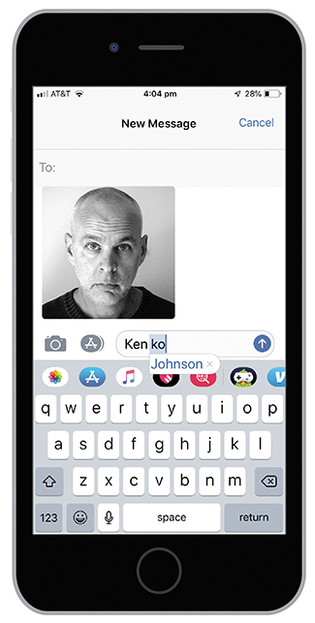 loading
loading
Where They Are NowEver wondered who created autocorrect?Ken Kocienda '88 was principal engineer on software for the iPhone.  Photo illustration: Mark Zurolo ’01MFA. Photo: Ken Kocienda.On his way to becoming the principal engineer of iPhone software, Ken Kocienda ’88 went to a motorcycle mechanics school, wrote for a New York area newspaper, and taught English in Japan. Now he has written a book on his nearly 16 years with Apple. View full imageThe keypad on your iPhone? Love it or hate it, you can thank Ken Kocienda ’88. A history major when he was at Yale, the former principal engineer of iPhone software at Apple took a circuitous path to tech. But he landed at Apple at a propitious moment. Kocienda has written a new book chronicling the nearly 16 years he spent there: Creative Selection: Inside Apple’s Design Process during the Golden Age of Steve Jobs. He spoke with the Yale Alumni Magazine about his work on projects ranging from the Safari browser to the iPad to the iPhone. Yale Alumni Magazine: What did you do between Yale and Apple? Ken Kocienda: I attended a motorcycle mechanics school, I worked at a newspaper in the New York area, and I taught English in Japan for two years. While I was in Japan, I compiled a portfolio of photographs, and I was accepted into a master of fine arts program for photography at the Rochester Institute of Technology, beginning in the fall of 1993. Before coming to Apple, I worked at a company called Eazel. My role was to develop network services—today we would call it cloud-based software. Unfortunately, Eazel didn’t make it. Many Eazel employees found positions at Apple. I did too. Y: Why did you write Creative Selection? K: When I joined the iPhone effort, there were very few software people [in] on that deep company secret. And when I left Apple, it struck me I had this unique perspective and a story I wanted to tell. Apple’s software and devices are so embedded in our lives. I wanted to let people know the technical side, like how these technologies were made and some of the creative approaches we took during the Steve Jobs era. Y: You designed the iPhone autocorrect function. What kind of feedback did you get? K: Actually, the most feedback that I have received over the years about autocorrect was that it gets in the way of people swearing! I did research on the worst things people call each other, but I made sure to include these foul words in the autocorrection dictionary. The idea was to be knowledgeable about this class of language. In the software, I annotated these types of words with a special marking that prevented the autocorrection software from suggesting or assisting people to type such awful things. Y: So today, that dictionary must be constantly updating, and not with just ethnic slurs but also new slang and company names, right? K: For sure. Those updates can never end, because language continues to evolve. The autocorrect dictionary is actually more of a catalogue of everyday life than it is a reference book. Y: You mention in the book how the Back button on the iPhone is “charged,” meaning it has a larger touch-surface area than a physical area, so someone can actually touch it if they don’t strike the exact visual button. K: For the touchscreen OS, the lesson we learned early on is that we felt apprehensive when we touched a small target on the screen—because what winds up happening is that when the finger gets closer to the surface, it obscures the target. So the “charged” idea evolved to give people what they meant to do rather than what they did. Y: You were one of the few Apple employees to demo for Steve Jobs and meet him in person. What was he like? K: He was incredibly focused and could be very intimidating. He never said more than he needed to. If he dispatched me quickly during a demo, I never saw it as disrespectful; he trained himself to be efficient with communication so he could make time for everything. Y: What else are you doing, besides writing? K: Now that the book is done, I’m considering what to do next. I have some public speaking engagements lined up for early 2019. After that, I might get another job at a software company. But maybe not.
|
|
1 comment
-

Pierre Groussac, 8:57pm March 15 2019 |  Flag as inappropriate
Flag as inappropriate
The comment period has expired.I really like this guy. He goes from history major thru motor cycles thru working at a newspaper thru photography in Japan to software engineering at Apple where he designs autocorrect. My problem with autocorrect is that it will correct me even when I know the word I want to use—something like having a virtual wife. Was Ken married when he designed this? Anyway, for those of you who haven't done anything this cool, not to worry. Enjoy the life you have. If no one ever comes to interview you about how great you are, it's absolutely fine. And if your son is better off at a community college than at Yale, then guide him to where he can find his own way, not the way others think he should be. You don’t need to design an autocorrect to do this. You are the auto-correct.